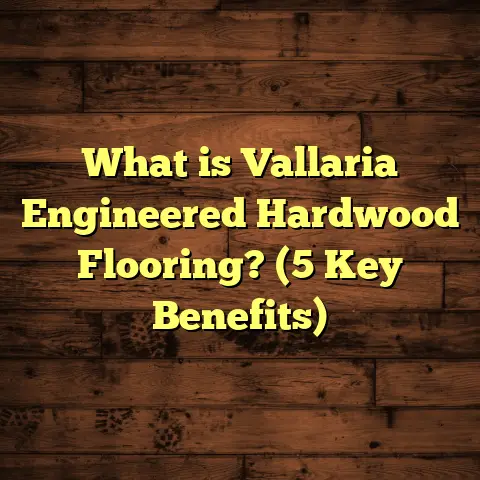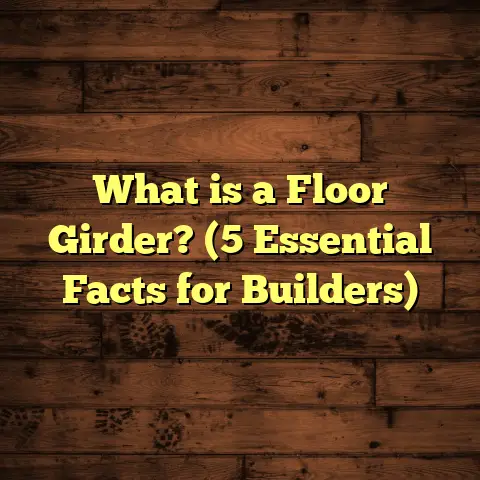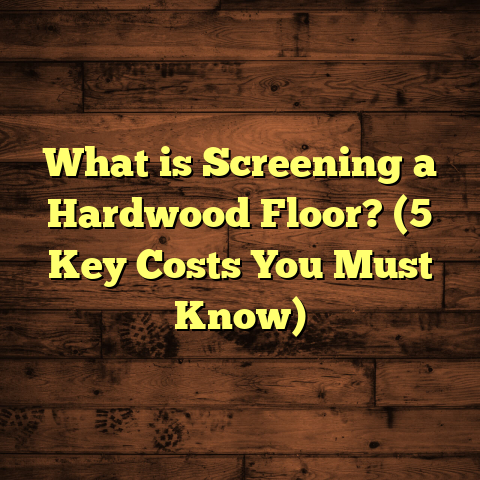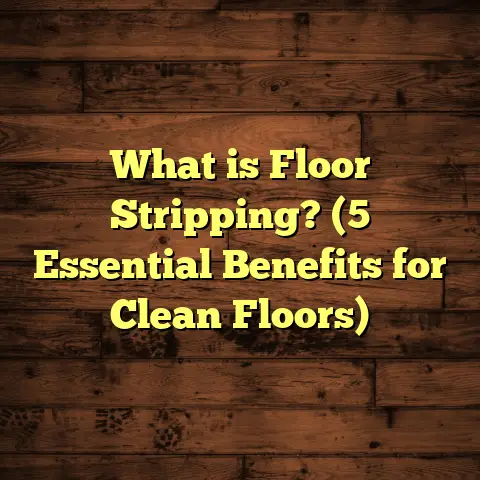What is Flexible Vinyl Flooring? (5 Benefits You Didn’t Know)
I remember the exact moment when I realized that flexible vinyl flooring could be a game changer for many homeowners and renovators like myself. I was knee-deep in a renovation project for a client’s older home. The subfloor was uneven, the budget tight, and the timeline short. I needed something durable, stylish, easy to install, and comfortable underfoot — and fast. After ruling out hardwood and ceramic tile due to cost and installation complexity, flexible vinyl flooring caught my eye. It turned out to be an excellent fit, but beyond that, it offered benefits I hadn’t fully appreciated before.
Flexible vinyl flooring is not just another flooring material — it’s a smart solution that combines practicality with style and affordability. For anyone contemplating a flooring upgrade, understanding what flexible vinyl flooring is and why it’s worth considering can open up new opportunities.
What is Flexible Vinyl Flooring?
Let’s start with the basics: what is flexible vinyl flooring? At its core, it’s a type of vinyl flooring made primarily from polyvinyl chloride (PVC), combined with plasticizers to create a soft, pliable sheet or tile. This flexibility distinguishes it from rigid vinyl planks or tiles.
The term “flexible” refers to the material’s ability to bend or curve without cracking or breaking. This flexibility allows easy installation over uneven surfaces or around complex room shapes. Flexible vinyl typically comes in large sheets or tiles, which are thinner and more pliable than rigid vinyl options.
Composition and Construction
Flexible vinyl flooring has multiple layers that work together to provide durability, comfort, and design versatility:
- Backing Layer: Provides stability and support.
- Core Layer: The thickest layer, often made of PVC mixed with plasticizers for flexibility.
- Decorative Layer: A printed design that mimics natural materials like wood, stone, or ceramic tile.
- Wear Layer: A transparent protective surface that guards against scratches, stains, and wear.
The plasticizers in the PVC mixture are crucial. They prevent the vinyl from becoming brittle and allow it to remain soft and flexible over time. Advances in manufacturing have reduced plasticizer migration — a problem where plasticizers evaporate or leach out, causing shrinkage or cracking — making modern flexible vinyl much more stable than older versions.
How Flexible Vinyl Differs From Other Vinyl Flooring
You might be wondering how flexible vinyl compares to other common vinyl types:
- Rigid Vinyl Planks/Tiles: Thicker, less flexible, often click-lock for floating installation.
- Sheet Vinyl (Flexible Vinyl): Thin sheets or tiles that can bend; usually glued down.
- Luxury Vinyl Tile (LVT): Often thicker rigid planks designed for high-end aesthetics and durability.
Flexible vinyl stands out for its ease of installation on imperfect floors and its affordable price point.
Why Flexible Vinyl Flooring?
I’ve worked with hardwoods, laminates, ceramic tiles, carpets — you name it. Each has its pros and cons. But flexible vinyl flooring offers an unusual mix of advantages that caught me by surprise during my projects.
Here are five benefits I didn’t expect when I first started using flexible vinyl flooring — benefits you might not have heard about either.
1. Comfort Underfoot That Makes a Difference
When you think about floors, comfort might not be your first thought. But after standing on hard tile or wood for hours during renovations or daily life, comfort becomes a big deal.
Flexible vinyl flooring has a softer feel underfoot than rigid floors. Thanks to its pliable core and cushioned backing layer, it absorbs some of your weight and pressure as you walk or stand on it.
A research paper from the Journal of Building Engineering found that floors with resilient layers can reduce muscle fatigue by up to 15% during prolonged standing compared to rigid surfaces. This was evident when I installed flexible vinyl in my own kitchen — cooking felt less tiring, standing for long periods was easier on my legs.
If you spend lots of time in your kitchen or laundry room, or if you own a business where employees stand all day (like a café or retail space), this comfort factor can improve everyday quality of life.
2. Flexibility Means You Can Skip Some Costly Prep Work
One of the biggest headaches in flooring projects is uneven subfloors. Older homes often have warped wooden floors or cracked concrete slabs that need expensive leveling before installing rigid flooring.
Flexible vinyl’s soft, bendable nature allows it to conform better to these imperfections without cracking or popping up after installation.
In one renovation I did on a 1950s house, the concrete slab was far from level — with dips and cracks — but instead of spending thousands on self-leveling compounds and extra labor, we installed flexible vinyl sheet directly after minor patching.
This saved my client time and money while delivering a beautiful finished floor that held up well over time.
3. Exceptional Water Resistance Extends Usage Areas
Most people know vinyl floors resist water better than wood or laminate. But flexible vinyl flooring takes this further because of its seamless sheet options and waterproof PVC composition.
It’s almost completely impervious to moisture. This makes it perfect for bathrooms, basements, kitchens, mudrooms — basically anywhere water might be a problem.
A study by the Flooring Industry Association showed that flexible vinyl sheets scored near-perfect in water resistance tests compared to laminate or engineered wood, which both suffered damage after prolonged exposure to moisture.
I’ve installed flexible vinyl in several basement remodels where flooding was a risk. The owners appreciated the peace of mind knowing their floors wouldn’t warp or mold during wet seasons.
4. Maintenance Is So Simple It Feels Like a Bonus
Anyone who’s ever struggled with caring for hardwood floors knows how much time sealing, polishing, and gentle cleaning takes.
Flexible vinyl flooring flips this on its head. It requires very little maintenance beyond regular sweeping and mopping.
The wear layer protects against stains — so spills wipe right off without soaking in. No special cleaners needed; regular household mop solutions work fine.
From personal experience managing rental properties, tenants are thankful for floors that don’t demand special treatment or costly maintenance products.
This low-maintenance feature saves time and money long term.
5. Style Options That Don’t Break the Bank
I love seeing how far flexible vinyl flooring has come in style versatility. Gone are the days when vinyl meant ugly patterns or cheap-looking surfaces.
Today’s flexible vinyl sheets come in thousands of designs mimicking hardwood grains, natural stones like marble or slate, ceramic tiles with grout lines — even trendy concrete looks.
Manufacturers use high-resolution printing technology to create realistic textures that fool even trained eyes.
What surprised me most is how affordable these options remain compared to real wood or stone. Material costs generally range between $1.50 and $4 per square foot for flexible vinyl sheets depending on design complexity.
Installation labor varies but typically runs lower than hardwood or tile because the material is easier to work with — no grout lines or precise plank fitting needed.
Using tools like FloorTally has helped me compare these costs quickly across materials and regions so I always provide clients with honest budget expectations.
Digging Deeper: How Flexible Vinyl Flooring Fits Into Modern Renovations
When I talk with homeowners now, I notice many are looking for solutions that blend style with practicality — especially those managing busy families or working from home.
Flexible vinyl meets these needs well:
- Kid-Friendly: Soft enough for falls but tough enough to resist scratches.
- Pet-Friendly: Water-resistant against accidents; easy cleanup.
- Eco-Friendly Improvements: Newer products incorporate recycled materials and lower VOC emissions.
- DIY-Friendly: Easy to cut and handle for homeowners wanting to tackle installations themselves.
- Commercial Viability: Durable enough for moderate commercial traffic like small offices or boutiques.
The versatility is one reason I recommend flexible vinyl so often when clients have specific functional demands but don’t want to sacrifice aesthetics.
Installation Insights From My Projects
I want to share some practical tips based on years of installing flexible vinyl flooring across various settings:
Surface Preparation Matters
Even though flexible vinyl can handle some unevenness, proper surface preparation still impacts long-term performance. The subfloor should be clean, dry, smooth (patch holes/cracks), and free of debris.
In one job in an old farmhouse kitchen, neglecting to patch a minor crack resulted in slight bulging weeks later. Lesson learned — prep is worth the effort.
Adhesive Choices Affect Longevity
Unlike click-lock planks, most flexible vinyl sheets require glue-down installation unless you opt for loose lay types designed for rental properties or temporary setups.
Choosing a high-quality adhesive compatible with your subfloor type ensures good bonding and prevents shifting over time.
Cutting and Fitting Tips
Flexible vinyl cuts easily with utility knives or specialized shears. When fitting around corners or intricate edges like cabinets or stair nosings, take your time measuring carefully.
I often recommend undercutting door jambs so sheets slide neatly underneath for cleaner edges.
Waste Factor Planning
Because flexible vinyl comes in large rolls or sheets, there will be some material waste during cutting. Including a waste factor of about 5-10% in your material order helps avoid costly last-minute purchases.
This is where FloorTally really shines — it automatically calculates waste based on room geometry so your order covers all bases without overspending.
Maintenance Routine That Keeps Your Floors Looking Great
Keeping flexible vinyl floors in top shape doesn’t require much effort:
- Sweep regularly with soft bristle brooms or vacuum with bare floor settings.
- Mop with mild detergent diluted in water; avoid harsh chemicals that can dull finish.
- Wipe up spills immediately to prevent slipping hazards.
- Use furniture pads under heavy pieces to avoid dents or scratches.
- Avoid dragging heavy objects across the floor.
I’ve found many clients appreciate how forgiving these floors are — minor scuffs can often be buffed out using recommended products without needing professional refinishing like hardwood does.
Frequently Asked Questions About Flexible Vinyl Flooring
I get asked these questions a lot by homeowners considering flexible vinyl:
Is Flexible Vinyl Flooring Durable Enough For High-Traffic Areas?
Yes! Especially commercial-grade products designed specifically for heavy use can last 10+ years even under daily foot traffic from dozens of people. Residential-grade options perform well in typical household environments too.
Can Flexible Vinyl Be Installed Over Radiant Heating?
Absolutely! Flexible vinyl’s thin profile allows efficient heat transfer when installed properly over radiant floor systems without cracking or lifting issues seen with wood floors.
How Does Flexible Vinyl Compare Environmentally?
Newer flexible vinyl products use lower-VOC formulas and increasingly incorporate recycled content. While vinyl isn’t biodegradable, responsible disposal programs exist in many regions to reduce landfill impact.
What Are Common Installation Mistakes To Avoid?
Poor surface prep leading to bumps or bubbles; using wrong adhesive causing peeling; insufficient acclimation time before installation causing expansion/contraction issues are common pitfalls I’ve encountered.
Can I Install Flexible Vinyl Flooring Myself?
If you’re handy with tools and follow manufacturer guidelines carefully, yes! Many DIYers enjoy installing flexible vinyl sheets because they don’t require complex locking systems or grout work like tile does.
Real-Life Stories From Clients Who Chose Flexible Vinyl
One client who runs a daycare center chose commercial-grade flexible vinyl because she needed waterproof floors safe for kids prone to spills and messes. She told me how impressed she was that even after months of heavy use and daily mopping, her floors looked brand new without any chips or stains — something she hadn’t experienced with carpet or laminate before.
Another client with two dogs loved how easy it was to clean up accidents quickly without lingering odors or discoloration. Her new floor also felt warmer than tile during cold winters — making her home cozier overall.
These stories highlight how versatile flexible vinyl can be for different lifestyles.
Cost Breakdown: What Should You Expect?
Let’s talk numbers because budget often drives decisions:
| Item | Typical Cost Range (per sq.ft) |
|---|---|
| Material (flexible vinyl sheet) | $1.50 – $4 |
| Installation Labor | $1 – $3 |
| Subfloor Prep (if needed) | $0.50 – $2 |
| Adhesive | Included/Varies |
| Total Installed Cost | $3 – $8 |
These costs vary significantly based on location, product quality, room size/complexity, and contractor rates.
Using FloorTally has helped me estimate these costs accurately by pulling local labor rates into calculations alongside material prices — saving guesswork and avoiding budget overruns during projects.
Comparing Flexible Vinyl To Other Popular Options
To help you see where flexible vinyl fits among other floors:
| Flooring Type | Average Cost/Sq.Ft | Durability | Maintenance | Water Resistance | Comfort |
|---|---|---|---|---|---|
| Flexible Vinyl | $3 – $8 | Medium-High | Low | Excellent | High |
| Hardwood | $6 – $12 | High | Medium | Poor | Medium |
| Laminate | $3 – $7 | Medium | Medium | Poor | Low |
| Ceramic Tile | $5 – $10 | High | Low | Excellent | Low |
| Carpet | $2 – $6 | Low | High | Poor | High |
This quick comparison shows how flexible vinyl strikes a balance between affordability, durability, moisture resistance, and comfort rarely matched by other options.
Final Thoughts On Why Flexible Vinyl Flooring Might Be Right For You
If you’re still wondering whether flexible vinyl flooring deserves a spot on your shortlist, here’s what I want you to remember from my experience:
- It offers comfort without sacrificing durability.
- It handles imperfect subfloors better than many alternatives.
- It excels in wet areas where other floors struggle.
- Maintenance is simple — no special cleaners needed.
- Style choices now rival traditional wood or stone looks but cost less.
- Installation flexibility saves money on prep work.
- It suits both residential and moderate commercial uses.
- Tools like FloorTally simplify budgeting so you can plan confidently.
When faced with complex renovation challenges or tight budgets myself, I often turn back to flexible vinyl because of how well it balances all these factors without compromising on aesthetics or performance.
Have you considered flexible vinyl flooring before? Or maybe you’ve already tried it? What was your experience like? Feel free to share questions or stories — I’m always happy to chat about finding the best floors for your home or project!
If you want me to help break down specific product lines or installation techniques further, just let me know!





